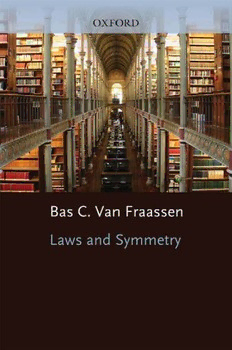
Laws and symmetry PDF
Preview Laws and symmetry
Laws and Symmetry This page intentionally left blank Laws and Symmetry Bas C. Van Fraassen CLARENDON PRESS · OXFORD GreatClarendonStreet,OxfordOX26DP OxfordUniversityPressisadepartmentoftheUniversityofOxford ItfurtherstheUniversity'sobjectiveofexcellenceinresearch,scholarship, andeducationbypublishingworldwidein OxfordNewYork AucklandBangkokBuenosAiresCapeTownChennai Dar esSalaamDelhiHongKongIstanbulKarachiKolkata KualaLumpurMadridMelbourneMexicoCityMumbaiNairobi SãoPauloShanghaiTaipeiTokyoToronto Oxfordisaregisteredtrademark ofOxfordUniversityPress intheUK andincertainothercountries PublishedintheUnitedStatesby OxfordUniversityPressInc., NewYork ©Bas C.vanFraassen1989 Themoralrightsoftheauthorshavebeenasserted DatabaserightOxfordUniversityPress(maker) Allrightsreserved.Nopartofthispublicationmaybereproduced, storedinaretrievalsystem,or transmitted,inanyform orbyanymeans, withoutthepriorpermissioninwriting ofOxfordUniversityPress, oras expresslypermittedbylaw, or under termsagreedwiththeappropriate reprographicsrightsorganization.Enquiriesconcerningreproduction outsidethescopeoftheaboveshouldbesenttotheRightsDepartment, OxfordUniversityPress,attheaddressabove Youmustnotcirculatethisbookinanyotherbindingorcover andyoumustimposethissameconditiononanyacquirer ISBN0–19–824860–1 To Etruscan places This page intentionally left blank Preface The idea that there are laws of nature is by no means the sole property of philosophers. That this idea is the key to what science is, often appears as self-evident in popular thought: in The History of Landscape Painting, John Constable writes‘Paintingisascience’andheadds,unconsciousofanyleapinthought,‘andshouldbepursuedasaninquiryinto thelawsofnature.’ Thatthese lawsconstitutealsowallsofimpossibilitythatborder thecourse ofevents, is a constant preoccupation of Dostoevsky's narrator in Notes from Underground: ‘all the same’, he says, ‘the laws of nature have mistreated me constantly, more than anything else in my life’. But the idea that there are such laws has also played a major role in philosophy concerned with science. We find this ideaperhapsmostprominentlyinthephilosopher-scientistsoftheseventeenthcentury,butitsurvivedinourseventhe logical positivists' radical rejection of history. Reichenbach, Hempel, and Goodman themselves invoked laws to shed light on issues prominently associated with their names. Their invocation was perhaps critical and tentative, but it seepedintootherareasofphilosophyascertainty.Whenmoralphilosophersdiscussfreewill,forexample,shouldthey not be allowed to lean on such certainties as philosophy of science has established concerning cause, necessity, counterfactuals, and nomological explanation?And similarly, given those supposed certainties, isn'titquite proper too for philosophy of mind to approach uncritically the question whether there are psycho-physical laws? In the first part of this book I shall argue that no philosophical accountof laws of nature does or can succeed. In the second I shallrebut theargumentthatwe must believe inthem nevertheless. Now if thereare laws of nature we must approach science in one way, but if there are no laws, we are freed to leave behind a whole range of traditional problems. I make a proposal for how to do philosophy of science, and devote the third and fourth part to contributions to the semantic approach (as Frederick Suppe baptized it) which I advocate. The emphasis will be on symmetry, as a key to theory, though not in the sense that laws were. This book was originally twice as long. When a general approach viii PREFACE isannounced and advocated, itremains hand-wavingexcepttotheextentthatitis implemented. Accordingly, thenow missing part was devotedto a detailed study of the structure and interpretation of quantum mechanics. It will appear separately, as Quantum Mechanics: An Empiricist View. My colleagues in philosophyof sciencemay be a littlesurprised by Part I, for the accounts of law taken up belong to theareaofmetaphysicswhichtheygenerallyignore.Theyareofcoursefreetoignorethatpartandturntothechapters on inference to the best explanation, theories, symmetry, classical physics, and probability. I too lack sympathy for metaphysics, though not in general: only for pre-Kantian metaphysics— and then only if practised after Kant. I have triedtoensureneverthelessthatnoneofmyargumentsrestsonthisrejection;otherwisemycritiquewouldnotbevery effective.Thosewhodon'tcaretoengagethemetaphysiciansontheirownground,Iwouldliketourgeatleastthis:do notrelyonsuchconceptaslawwithoutinquiringwhether thereisanythingthatcouldplaytherequiredrole.Forthatis similar to other philosophers relying unquestioningly on fifty-year-old philosophy of science. There are many peopleand institutions I want to thank. The original manuscriptwas writtenduring a sabbatical leave (1986/7) supported byPrinceton Universityand theNational ScienceFoundation. Specific debts are acknowledged in manysections,butIwishtothankErnanMcMullen,DavidLewis,StorrsMcCall,WesleySalmon,MichaelTooley,and Richard Foley for special help with Part I. For Part II I want to acknowledge the help and insights received from GilbertHarman,RichardJeffrey,andBrianSkyrms.ElisabethLloydhelped metoseenew possibilitiesinthesemantic approachtotheories, and R. I. G. Hughesinthemanyuses ofsymmetry. DiscussionswithBrian Skyrms, Maria-Carla Galavotti,and Nancy Cartwright helpedwithcausality, while Roger Cooke helped with theintricaciesof bothclassical mechanics and subjective probability. Joint work withR. I. G. Hughes appears in thelast chapter. Perhaps needless to say,itwasmyvaluedteacher WilfredSellars andmyeventualcolleagueGilbertHarmanwhostartedmeonthesubject of inference to the best explanation, a number of years ago. Margot Livesey suggested a good deal of stylistic improvement in the first three chapters and I hope this had its effect on the later ones as well. PREFACE ix Anne Marie DeMeo typed endless drafts of this material over a period of about three years, and kept my practicallife functioning even while I travelled; she deserves special thanks. Finally, I want to acknowledge with some nostalgia the places where I wrote the draft during that initial year: Vancouver, Victoria (BC), Montreal, Notre Dame, Bologna, Assisi, Rome, Jerusalem, Tiberias, Cambridge (Mass.), Cleveland, and London.
